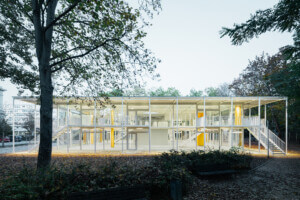For clients who wanted two separate houses, one for the first floor and one for the ground floor, they couldn’t have found a better architectural match than in Fake Industries Architectural Agonism and Aixopluc. Headed up by Cristina Goberna and Urtzi Grau, the New York–based firm is constantly exploring new approaches to architecture. One of Grau and Goberna’s theories is on expanding the possibilities of replicating and copying architecture, and they have written a monograph on the topic: Architectural Replicas: Four Hypotheses on the Use of Agonistic Copies in the Architectural Field.
As a result, the OE House in Alforja, Spain, is a mash-up of a Case Study house on the ground floor with Le Corbusier’s Maison Jaoul on top. The Case Study house is for summer use while Maison Jaoul is for winter. It is, as Fake Industries puts it, an architectural “exquisite corpse.” The clients wanted to be able to completely close off one “house” and then move to the other “house,” depending on the season and their current needs. “There are two different ideas of domesticity,” Grau said. “The sense of enclosure [on the upper level] and a traditional Catalan rural style of home, then the airy Case Study on the ground floor that has a relationship to the outside and the landscape.”
| RESOURCES: Architects Aixopluc Construction Engineer Jordi Royo Engineer Josep Maria Delmuns |
||
The challenges of this construction—super heavy and robust on top and permeable and light on the bottom—as well as what elements, like the staircase, could be used to reconcile the two, took careful planning. Fake Industries, in collaboration with Aixopluc, developed open-source systems and interchangeable components so that the house could be completed in 12 months. But “it was hard to find someone to do dry construction in Spain; specialized workforces who could do things like the brickwork are disappearing,” Grau said. All in all, it took five years to complete the house due to the economic crisis in 2008 and initially selecting the wrong contractor.
However, throughout the five years, the house became a part of the family’s history. They lived across the street, and their children grew up playing in the construction site and watching the house gradually rise. It was completed January 2016; the family has moved into the second floor while the first floor is currently a massive playground. “It is very similar to the way the Eameses had their living room organized—as a place to play,” Grau said. “And it’s like the Case Study houses where the social aspect and relationship were more important than the furniture itself; that is already emerging naturally here.”










